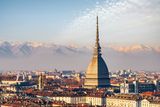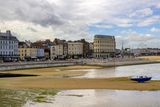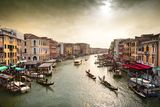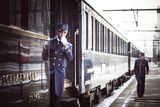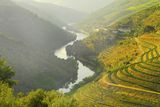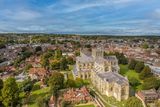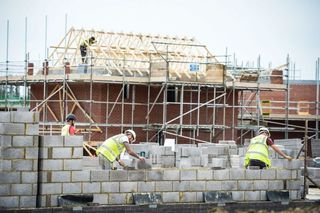Vienna in winter: Sweet temptations
There's magic in the air...
Tiny white lights twinkling from treetops. Soulful violin notes filling the air. Horses' hooves clip-clopping through the streets. The sweet smell of roast chestnuts.
It may only be a couple of hours away from Dublin, but at this time of year Vienna feels like travelling to a different era entirely. The Austrian capital is a beautiful city - this much we know. When the temperature drops and the first snow clouds begin to gather, however, it really comes into its own.
I had always wanted to visit during the winter months (in my mind's eye, I had conjured up images of cobbled streets alive with old-fashioned charm), and I wasn't disappointed. Arriving on a crisp, sunny morning, I took the fast train from the airport to the city centre and checked into the plush Palais Hansen Kempinski Hotel. Located on Schottenring, the five-star was undoubtedly luxurious, but with a relaxed and friendly atmosphere.
I didn't linger long. Opulent as the Kempinski was, I was impatient to check out the historic city, so once my luggage had been deposited and another layer of clothing added, I headed out in search of culture, tradition… and cakes.
Ah yes, cakes. From Florentines and cookies to apple strudel and chocolate cake, sweet temptation is everywhere in Vienna. Using my need to acclimatise to the cold gradually as justification, I slipped inside the first deliciously cosy café for a slice of sticky strudel.
Ice skating at Old Town Hall, Vienna
Suitably restored with my first Austrian delicacy, I had places to visit, music to listen to and more food to try. I needed to get my skates on - metaphorically of course. Unfortunately, I am cursed with a herniated disc, which precluded me from attempting to ice-skate at the Old Town Hall (pictured above), curl or try any number of other winter sports available in Austria at this time of year. But there was plenty more to keep me busy.
Vienna is the only capital city in the world that produces its own wine, for instance. A trip out to one of the vineyards is a must, so I jumped on a tram and headed a few kilometres out of the centre to see where Wiener Gemischter Satz is made.
With over 700 hectares given over to vines, it feels extraordinary to be so close to the metropolis while surveying the picturesque landscape. Tours of the actual vineyards have to be booked in advance, but chance visitors can enjoy a visit to the cellar, a wine tasting and a selection of home-cooked Austrian dishes. I opted for a cheese plate with a few tasty morsels of local varieties, which were the perfect accompaniment to my chilled glass of Beerenauslese… an unusual Christmas treat, but a treat nonetheless.
After a couple of hours in the wine-growing suburbs, I headed back to town just in time to see the first twinkle of Christmas lights. I felt a tingle of excitement at the sight of trees festooned with fairy lights, giant glittering baubles swaying over the streets and the warm glow from hundreds of wooden cabins in the markets.
A Christmas bauble hangs at a market in Vienna.
Far from the mayhem of Ireland's high streets at this time of year, my first Viennese shopping experience was a pleasure. Everything was either traditional or artisan - from wooden toys, silver jewellery and beeswax candles to local honey, sausages and chocolate. Perhaps it was the lack of mass-produced items, the absence of glitzy modern decorations, or the ever-present sound of music, but there seemed to be magic in the air.
Part of the allure of a city break is leaving dietary guilt behind, so while I didn't indulge in anything heavier than a warm rum punch at the market, my first evening was spent at the Edvard restaurant in Schottenring - where four courses of local dishes were delivered for inspection, each one more delicious than the last. Yum.
The following morning, I was greeted by Alexa Brauner, a local tour guide who took me on a walking tour of the city. As an art-historian, Alexa's knowledge was second-to-none and in perfect English, she pointed out famous buildings, monuments and the various homes and watering holes of many famous names including Sigmund Freud, Mozart and Beethoven.
It felt strange to stand under the balcony at the Habsburg Palace - where Hitler informed the people of Vienna that Austria was to be assimilated into the German Reich - but the reality of its past seemed to add to the rich history of the city. This is what sets Vienna apart from other European capitals, I think. They all have a similar historical timeline, but this town seems to have maintained its link with the past despite being firmly entrenched in the 21st century.
Streets of Vienna, Austria
The 'Golden Quarter' is the city's elite shopping area, and home to some of the world's most exclusive brand names. It sits quite happily alongside the intricate architecture of the old city and the horse-drawn carriages which seem more plentiful than cars.
Added to this is the fact that the city is steeped in musical history. Vienna was, of course, a creative hub for some of the world's best composers. Everyone from Mozart to Strauss and even Vivaldi had a strong connection to this imperial city, and their influence is still very apparent today - from the ticket sellers dressed in vintage robes to the concert goers striding through the streets in white tie and tails; even the buskers wear evening attire as their hauntingly beautiful notes float on the cold winter air.
Aside from the music, the history and the strudel, Vienna is also famous for its signature dish - the schnitzel. No visit would be complete without tasting one. Having asked several locals about where and when to nab the best, it seemed the only place to taste this quintessential Austrian food was Plachutta.
The restaurant was heaving. Luckily, my concierge had the foresight to book me a table, so I not only got to try the signature dish, but also the 'Martini goose' that Austrians love to gobble at this time of year. The schnitzel was nice, but the goose was gorgeous. The following morning, I headed to Hofburgkapelle to hear the Vienna boys' choir at holy mass. This was very special - their sweet voices were accompanied by the Philharmonic Orchestra and at times the Vienna Men's Choir. And after being serenaded for over an hour, I emerged somewhat dazed into the winter sunshine.
A Lipizzaner Stallion as the Spanish Rising School in Vienna
Next stop was the Spanish Riding School, set just across a large courtyard. The daily show was sold-out, but I saw the famous Lipizzaner stallions doing their morning exercise. This was equally impressive and if truth be told, I don't think I would have lasted the 90-minute performance.
The rest of the day was spent exploring the city, from the frosty-breathed artistic markets in Karlsplatz to the Museum Quarter, the Schonbrunn Palace (pictured top) and in the footsteps of The Third Man (underground tours are available), to the 100-year-old big wheel at the Prater amusement park.
There was still one thing I had to do -taste the world famous Sachertorte at the Sacher Hotel. There was a queue snaking around the building, but I had reserved a table and was ushered into the opulent café; where with great solemnity a suited waiter presented my slice. The recipe is kept under lock and key in the hotel vault. It summed up the city to perfection - rich, full of flavour, history, tradition and above all, class.
Read more
Read more:
Top three attractions
The Spanish Riding School
The Spanish Riding School in Vienna trains both horse and rider to move in harmony, resulting in a display that's half military manoeuvre, half dance. In 2015 it celebrates 450 years in existence. See srs.at.
Sachertorte
Created by 16-year-old chef Franz Sacher in 1832, this is the ultimate chocolate cake. The secret recipe is only know at the hotelsacher.com.
Vienna Boys' Choir
There is not one but four Vienna Boys' Choirs on the go at any one time, giving concerts, touring and recording albums featuring the music of classical composers such as Mozart and Schubert. Tickets start from €9, see wienersaengerknaben.at.
Getting there
Aer Lingus (aerlingus.com) flies direct from Dublin to Vienna, with fares starting from €71.99 per person each way.
Accommodation at the Palais Hansen Kempinski Hotel (kempinski.com) starts from €279 per room, and the Hotel Fuerst Metternich (hotelfurstmetternich-hrez.com) from €67 per night.
For restaurant reservations see Plachutta (plachutta.at) and Hotel Sacher (hotelsacher.com). Booking ahead is recommended.
Walking tours available from alexabraunder.at. For more information on things to do in Vienna, visit wien.info.
Join the Irish Independent WhatsApp channel
Stay up to date with all the latest news
